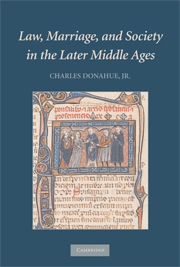Book contents
- Frontmatter
- Contents
- List of Tables
- List of Appendices
- Preface
- Acknowledgments
- Notes About This Book
- Introduction
- 1 The Background Rules and Institutions
- 2 Lying Witnesses and Social Reality: Four English Marriage Cases in the High Middle Ages
- 3 Statistics: The Court of York, 1300–1500
- 4 Story-Patterns in the Court of York in the Fourteenth Century
- 5 Story-Patterns in the Court of York in the Fifteenth Century
- 6 Ely
- 7 Paris
- 8 Cambrai and Brussels: The Courts and the Numbers
- 9 Cambrai and Brussels: The Content of the Sentences
- 10 Divorce a mensa et thoro and salvo iure thori (Separation)
- 11 Social Practice, Formal Rule, and the Medieval Canon Law of Incest
- 12 Broader Comparisons
- Epilogue and Conclusion
- Bibliography and Abbreviations
- Subject Index
- Texts and Commentary
- Table of Cases
- Table of Authorities
- Index of Persons and Places
11 - Social Practice, Formal Rule, and the Medieval Canon Law of Incest
Published online by Cambridge University Press: 14 July 2009
- Frontmatter
- Contents
- List of Tables
- List of Appendices
- Preface
- Acknowledgments
- Notes About This Book
- Introduction
- 1 The Background Rules and Institutions
- 2 Lying Witnesses and Social Reality: Four English Marriage Cases in the High Middle Ages
- 3 Statistics: The Court of York, 1300–1500
- 4 Story-Patterns in the Court of York in the Fourteenth Century
- 5 Story-Patterns in the Court of York in the Fifteenth Century
- 6 Ely
- 7 Paris
- 8 Cambrai and Brussels: The Courts and the Numbers
- 9 Cambrai and Brussels: The Content of the Sentences
- 10 Divorce a mensa et thoro and salvo iure thori (Separation)
- 11 Social Practice, Formal Rule, and the Medieval Canon Law of Incest
- 12 Broader Comparisons
- Epilogue and Conclusion
- Bibliography and Abbreviations
- Subject Index
- Texts and Commentary
- Table of Cases
- Table of Authorities
- Index of Persons and Places
Summary
THE RULES AND THEIR APPLICATION
Our examination in some depth of marriage litigation in five medieval church courts has revealed relatively few cases that dealt with the complicated rules, outlined in Chapter 1, about the marriage of relatives. This finding may be surprising to some readers. A view popularized by F. W. Maitland in a footnote (but which had roots going back to the Reformation) holds that the medieval incest rules were so complicated and so extensive that all medieval marriages were dissoluble as a practical matter, because virtually any couple could get a divorce by showing some hitherto unsuspected relationship between them. This view was founded on more than speculation. Medieval history offers a number of examples of highly visible divorces granted or sought on the ground of incest: Robert the Pious and Bertha of Burgundy in the eleventh century, Eleanor of Aquitaine and Louis VII of France in the twelfth, Philip Augustus and Ingeborg of Denmark in the thirteenth.
Even before the analyses presented in this book, research had cast considerable doubt upon this view. What research had shown was the danger of writing legal history from causes célèbres. The visible is not necessarily the usual; high politics affects both the law and its application in ways that make it difficult, if not impossible, to draw conclusions about the normal from the spectacular.
- Type
- Chapter
- Information
- Law, Marriage, and Society in the Later Middle AgesArguments about Marriage in Five Courts, pp. 562 - 597Publisher: Cambridge University PressPrint publication year: 2008



